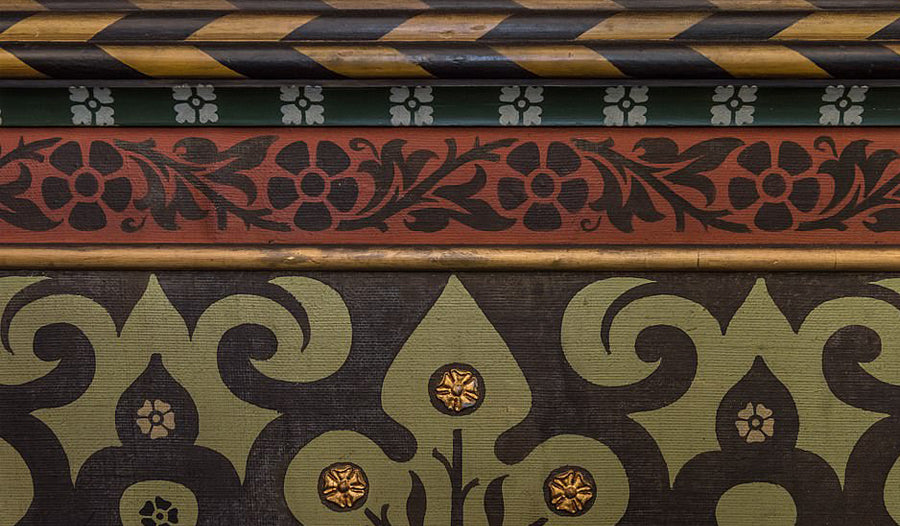
The David Parr House

David Parr was a ‘decorator’ artist who worked for some of the best known designers of the day including William Morris and George Bodley. He decorated churches and palaces for those who could afford it but in his spare time he decorated his humble terraced house in Cambridge in the same style. Lived in by his granddaughter until a few years ago, its interior remained a wondrous hidden secret. Now it will be saved, restored and opened up to the public.
Tamsin Wimhurst is a Trustee and founder of the David Parr House Charity which was set up in 2014 in order to conserve the house. A researcher and curator, she is also a passionate supporter of small independent museums, with a special interest in the ‘local’ where she sees the nation’s history unfold through the lives of individuals and their families. Tamsin will be delivering a online talk, The David Parr House - An Extraordinary Cambridge House, in collaboration with the Gordon Russell Design Museum on 25 June 2021 at 6pm. Find out how to book tickets on the Gordon Russell Design Museum website.

Truly a treasure trove of the decorative arts, we discussed the David Parr House in Selvedge Issue 90 West in the article, No Ordinary Life: A Small Terraced House in Cambridge, written by Emma Rose Barber. Read on for an excerpt of the article, which covers Parr’s incredible decorative schemes, as well as the narrative of the remarkable design vision of his granddaughter, Elsie Palmer, who lived in the house for over 80 years.
In 1886, a modest looking bearded gentleman in a dark jacket bought a small house in Gwydir Street, Cambridge. His name was David Parr. He was a decorator for F.R. Leach in the City Road, where he had apprenticed, learning to adorn walls with designs drawn from the fields, groves, dales and pastures of the natural world. In the evening, in his ordinary looking house, he applied his skills in stencilling, patterning, painting, pouncing, graining and gilding to create an extraordinary home.
Parr belonged to the legacy of designer-decorators aligned to the Victorian visionary, William Morris, who sought to revive the pre-industrial artistic skills of the middle ages. Parr was a true workman; an anonymous craftsman putting into practice the designs of the master. In doing so, he worked in the tradition of medieval and Renaissance studios, where the master was the workshop and the workshop was the master. An elegant euphemism for keeping the artisan anonymous.

Parr was too modest to seek fame through the decoration of his home. Working out of the spotlight, he embellished his walls with trailing plant forms, braiding, interweaving, threading, looping and curling. Interspersed with these were bursts of colour from flowers and petals, like the borders of a medieval manuscript or embroidery. The walls of his dining room and drawing room came to look as if the garden had come inside.
As well as Parr’s incredible decoration work, the house has another narrative, one that has brought it into the 20th century almost unchanged. This is because Parr’s granddaughter Elsie Palmer was also a designer, though she may not have thought herself as such. Palmer moved into the house in 1927 when she was 12, following the death of her grandfather, to be a companion to Parr’s widow Mary. She lived in the house - where she brought up her own family - until her death in 2013. Remarkably, Palmer changed very little of the interior decoration and through that choice, she left Parr’s vision complete.
To visit is to enter a space that has the mood and feel of a late 19th century domestic interior, with only a few later additions. Whether consciously or not, Palmer, in the words of the curator ‘juxtaposed’ things, creating her particular aesthetic. There is, for example, a panel of stained glass put in by Parr which, when the curtains at the window are closed can still be seen. Palmer was a woman who ‘made do’ and if there was not quite enough curtain material to cover a window, it did not matter. She had lived through two world wars, and lived frugally. Her reverence for her grandfather’s work is echoed in the curator’s decision to leave the traces of her life in the house…
Find out how to read the rest of the article here: Issue 90 West

The David Parr House also runs fascinating virtual 3D tours of the house. At the end of the guided tour, participants have the opportunity to explore the 3D house and access additional content through ‘hotspots’ embedded in every room. Watch conservation videos, listen to audio memories and the sounds of the house, find out more through photographs and documents – there is a wealth of information to explore which ticket holders can access for around 48 hours after the tour.
The David Parr House is one of the first heritage organisations to use this technology, more often associated with estate agencies, in this way, with the guides able to conduct immersive tours from the safety of their homes, directly into yours. Find out more about their Personal Guided Online 3D Tours on the David Parr House website.
Images courtesy of David Parr House. Copyright Helena G Anderson.
